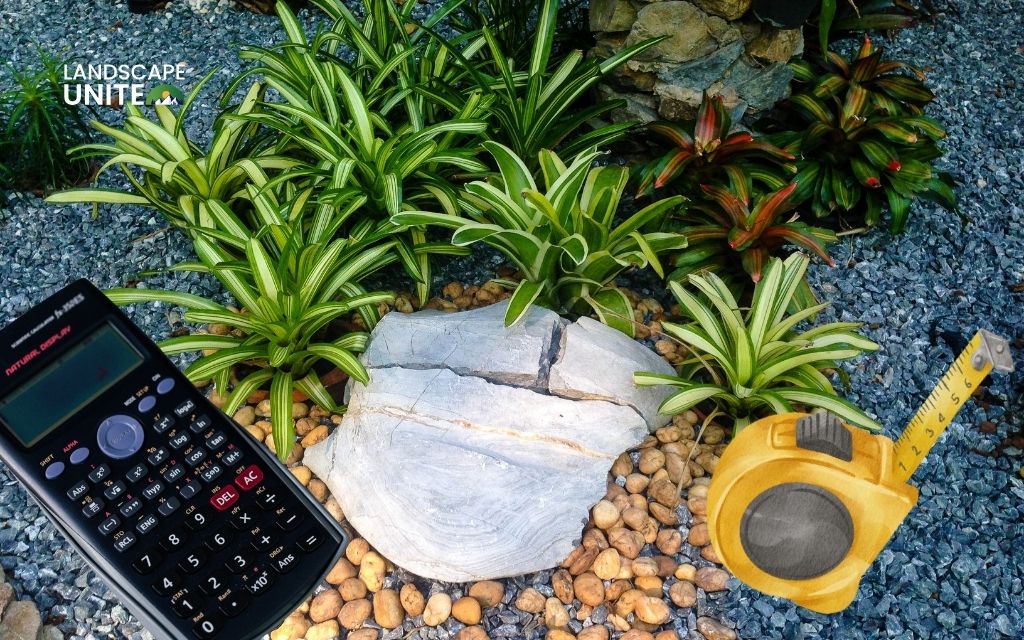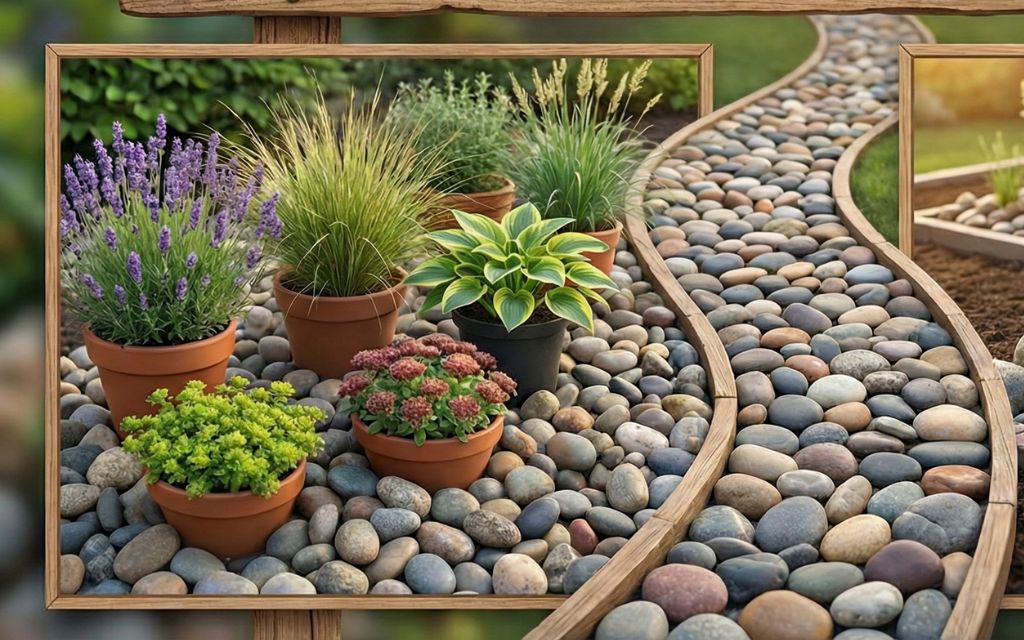Maintaining pristine artificial grass doesn’t have to be complicated. Whether you’re dealing with everyday dirt accumulation or pet-related messes, proper cleaning techniques will keep your synthetic turf looking vibrant and fresh for years to come.
This comprehensive guide walks you through proven methods to maintain your artificial lawn effectively, ensuring it remains a beautiful and functional part of your outdoor space.
How to clean artificial grass?
Maintaining artificial grass requires a systematic approach that addresses different types of debris and stains. Following these detailed steps ensures your synthetic turf stays clean, odor-free, and visually appealing throughout the seasons.
1. Remove debris regularly
Organic matter like leaves, twigs, and accumulated dust can trap moisture against your artificial grass fibers, potentially leading to mold growth and deterioration of the turf backing material.
Establish a regular debris removal schedule, particularly during autumn months when leaf fall is heaviest, to prevent moisture retention and maintain optimal drainage.
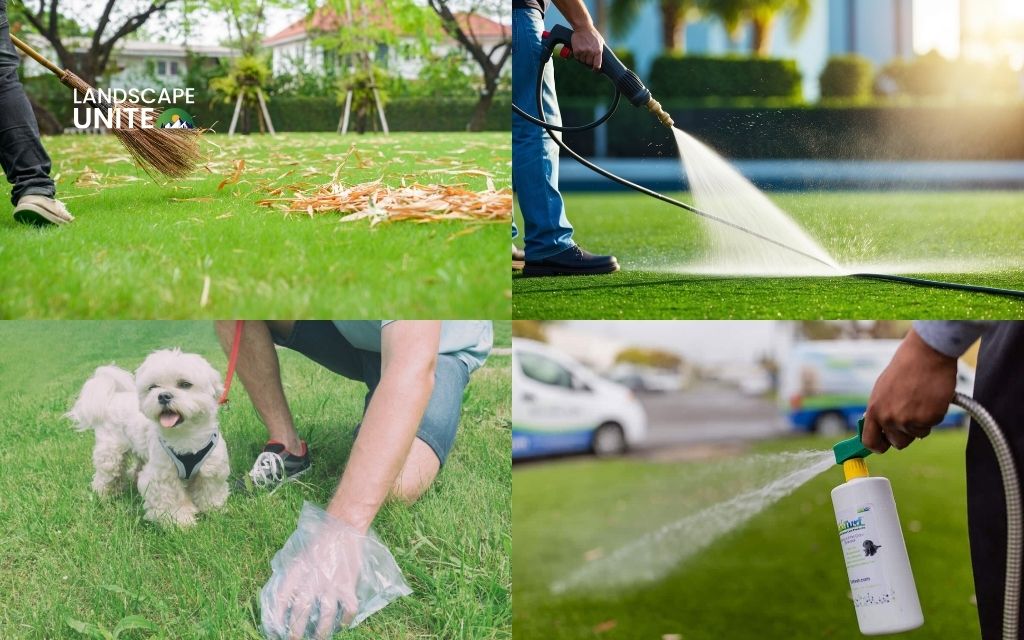
2. Wash the turf with water
Regular water irrigation removes accumulated dirt, pollen, and light staining while refreshing the artificial grass fibers and maintaining their upright position.
- Utilize a standard garden hose with adjustable nozzle settings for controlled water pressure
- Apply low-pressure washing techniques to avoid displacing infill materials
- Concentrate on high-traffic zones and areas exposed to pet activity or spills
Schedule thorough rinsing bi-weekly or following weather events to maintain optimal cleanliness and prevent buildup of environmental contaminants.
3. Remove pet waste immediately
Animal waste contains bacteria and compounds that can create persistent odors and potentially damage artificial grass backing if left untreated.
- Collect solid waste using protective gloves or specialized waste removal tools
- Address liquid waste by flooding the affected area with water to dilute and disperse urine
- Apply enzyme-based cleaners specifically formulated for synthetic turf applications
Implement immediate cleanup protocols and follow with pet-safe deodorizing products designed for artificial grass to maintain a hygienic outdoor environment.
4. Deep cleaning with detergent
Accumulated grease, sticky residues, and embedded stains require more intensive cleaning methods to restore artificial grass appearance and prevent permanent discoloration.
- Create a solution using mild, non-abrasive detergent mixed with warm water
- Apply cleaning solution using a soft-bristled brush, working in circular motions
- Rinse thoroughly with clean water to eliminate all soap residue and prevent fiber damage
Avoid harsh chemical cleaners or bleach-based products that can degrade synthetic fibers and cause permanent color fading or texture changes.
How to clean fake grass from dog urine
Pet ownership presents unique challenges for artificial grass maintenance, particularly regarding urine odor control and stain prevention. Understanding proper cleaning techniques ensures your synthetic lawn remains fresh and hygienic for both pets and family members.
Clean pet urine with water
Dog urine contains high concentrations of ammonia and urea that can create persistent odors and attract additional marking behavior if not properly neutralized.
- Immediately saturate the affected area with substantial amounts of water
- Use pressure washing on low settings to ensure complete urine dilution and removal
- Focus treatment on frequently used pet areas to prevent odor concentration
Address urine spots within minutes of occurrence to prevent ammonia crystallization and ensure complete odor elimination from artificial grass fibers.
Use pet-safe cleaning products
Standard household cleaners may contain toxic chemicals harmful to pets, while specialized products effectively neutralize organic waste without compromising pet safety.
- Select enzyme-based cleaners specifically certified for artificial grass applications
- Apply cleaning products according to manufacturer instructions, allowing proper contact time
- Choose non-toxic, biodegradable formulations that won’t harm pets or surrounding vegetation
Invest in products featuring live enzyme cultures that continue breaking down organic matter over time, providing long-lasting odor control and stain prevention.
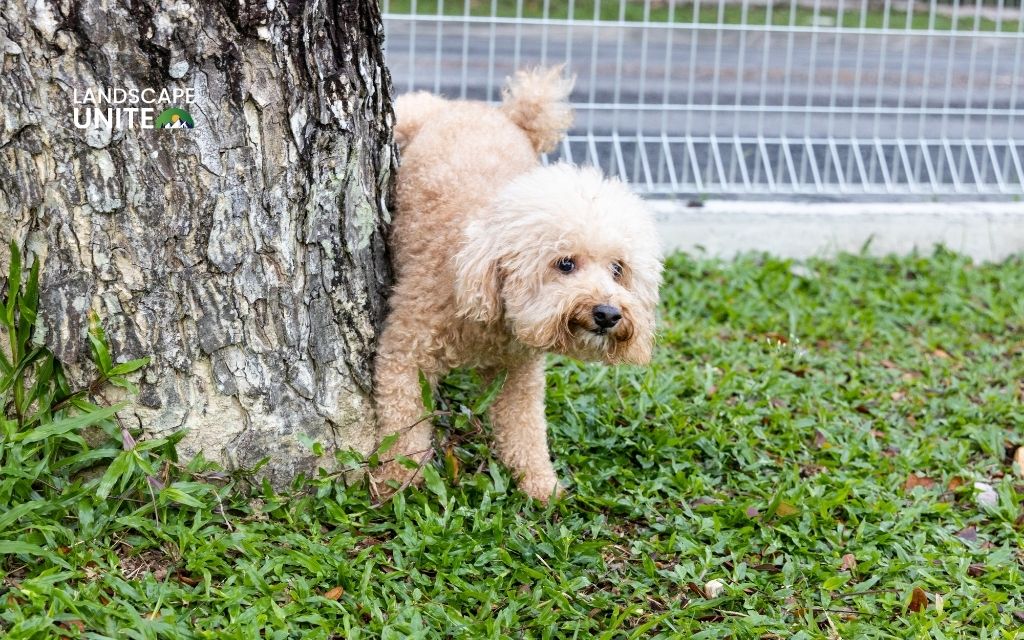
How often to clean fake grass from dog urine
Establishing appropriate cleaning frequencies prevents odor buildup and maintains artificial grass longevity while accommodating varying household needs and pet activity levels.
Frequency of cleaning
For pet owners:
- Daily maintenance: Remove all solid waste immediately upon discovery to prevent bacterial growth and odor development
- Weekly treatment: Perform comprehensive rinsing of entire artificial grass area to prevent urine concentration and odor buildup
- Monthly deep cleaning: Implement thorough cleaning protocols using specialized products to ensure long-term freshness and hygienic conditions
For non-pet owners:
- Maintain artificial grass through monthly cleaning routines focusing on debris removal and general maintenance to preserve appearance and functionality
Signs you need to clean more often
Noticeable ammonia or organic waste smells indicate inadequate cleaning frequency and require immediate attention to prevent permanent odor embedding.
Yellow or brown patches signal urine concentration or other staining that demands prompt treatment to prevent permanent grass discoloration.
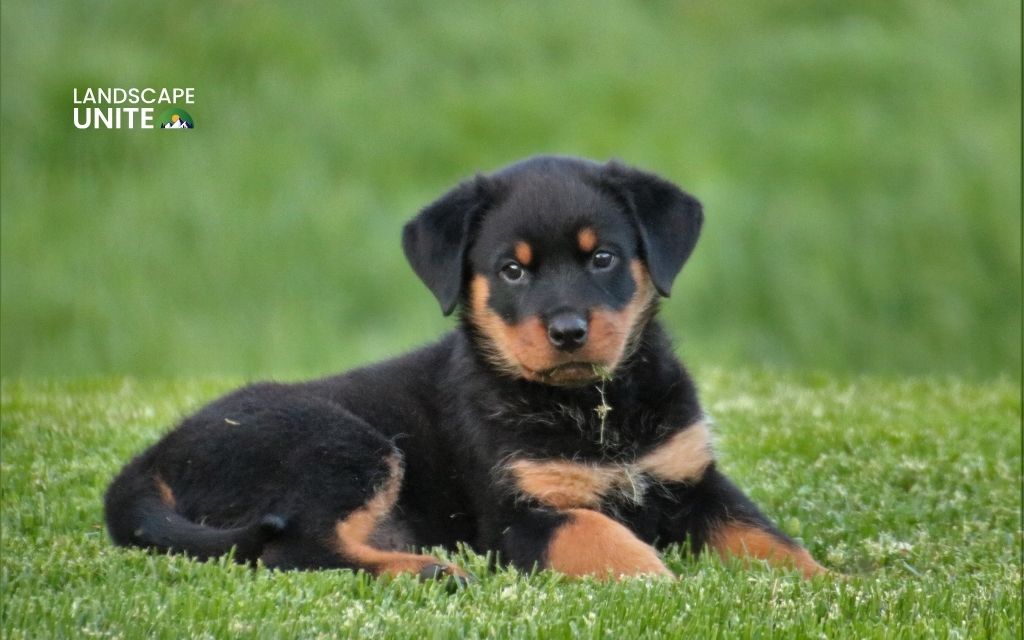
Equipment and products for artificial grass cleaning
Selecting appropriate tools and cleaning products ensures effective maintenance while protecting your artificial grass investment from damage or premature wear.
Cleaning tools
- Leaf blower or rake: Essential for efficient debris removal across large artificial grass installations without damaging synthetic fibers.
- Garden hose or low-pressure washer: Provides controlled water application for regular rinsing and targeted cleaning applications.
- Utility brush or stiff-bristled broom: Enables effective scrubbing action for stain removal while maintaining proper fiber orientation.
- Pet-safe deodorizer: Specialized products designed to neutralize odors while maintaining safe conditions for pets and family members.
Cleaning products
- Enzyme cleaners: Biologically active products that break down organic waste at the molecular level, providing superior odor control and stain removal.
- Artificial grass cleaner: Purpose-formulated solutions designed specifically for synthetic turf applications, ensuring compatibility and effectiveness.
- Mild detergent: Gentle cleaning agents suitable for routine maintenance without risking fiber damage or color degradation.
Conclusion
Proper artificial grass maintenance combines regular routine care with targeted cleaning techniques to address specific challenges like pet waste and environmental contamination.
By implementing these proven methods and maintaining consistent cleaning schedules, your synthetic turf will continue providing beautiful, functional outdoor space for years to come.
The key to successful artificial grass care lies in prevention through regular maintenance and prompt attention to spills or waste. This proactive approach ensures your investment maintains its appearance, functionality, and hygienic properties while providing a safe environment for pets and family enjoyment.
Ready to transform your outdoor space with professional landscaping expertise?
Explore our comprehensive resources covering artificial grass installation techniques, innovative design concepts, and complete landscaping solutions to create the perfect outdoor environment for your home.
Frequently asked questions (FAQs)
How do I clean dog urine off artificial grass?
Clean dog urine by flooding the area with water to dilute and disperse the waste, followed by application of enzyme-based cleaners designed for artificial grass. This two-step process ensures complete odor elimination and prevents permanent staining.
How often should I clean my artificial grass?
Pet owners should perform daily solid waste removal, weekly rinsing, and monthly deep cleaning. Non-pet owners typically require monthly maintenance focusing on debris removal and general upkeep to maintain optimal appearance.
Can I use a pressure washer to clean my artificial grass?
Yes, pressure washers are effective for artificial grass cleaning when used on low-pressure settings. High pressure can damage fibers or displace infill materials, so maintain gentle water pressure throughout the cleaning process.
How do I prevent my artificial grass from smelling?
Prevent odors through immediate waste removal, regular water rinsing, and application of pet-safe deodorizing products. Consistent maintenance and prompt attention to spills effectively prevents odor development and bacterial growth.
What’s the best cleaner for artificial grass?
Enzyme-based cleaners specifically formulated for synthetic turf provide optimal results. These products safely break down organic waste while maintaining artificial grass integrity and ensuring pet safety throughout the cleaning process.
